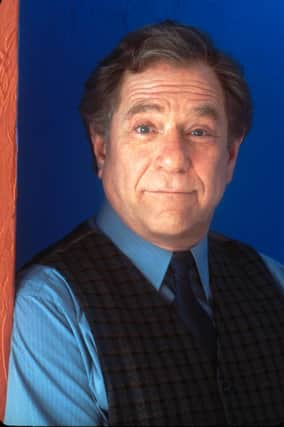Obituary: George Segal, genial Hollywood leading man of Seventies cinema


It may be difficult to believe now, but George Segal was once one of the biggest stars in the Hollywood firmament, sharing top billing in the 1970s with Barbra Streisand, Robert Redford and Jane Fonda. Segal specialised in self-centred characters struggling with modern life, love and the concept of commitment, but ultimately good-hearted and lovable. It was suggested that he was the very epitome of Modern Western Man.
“Segal has come to represent, in a genial and slightly ironic way, the modern American urban man… cynical but worried, easy going-but hard-working, able to use humour as a defence when nothing else will work,” wrote critic Ken Wlaschin in The World’s Great Movie Stars in 1979.
Advertisement
Hide AdAdvertisement
Hide AdSegal did some heavyweight drama in his time. He won an Oscar nomination co-starring alongside Richard Burton, who he liked, and Elizabeth Taylor, on whom he was less keen, in the 1966 domestic film Who’s Afraid of Virginia Woolf? And he starred in Ingmar Bergman’s 1973 television drama The Lie.
He gravitated from heavyweight drama towards knockabout romantic comedies, playing opposite Streisand in The Owl and the Pussycat and Glenda Jackson in A Touch of Class, the film for which Jackson won her second best actress Academy Award.
Like some of his characters, Segal seemed to have settled for the easy options, cosy comfort rather than naked emotional honesty. But then he pulled out of the film 10. Producer Blake Edwards hired Dudley Moore and sued Segal. The film was huge, Moore’s star rose and Segal’s career was never quite the same.
Subsequently he appeared in occasional supporting roles in major feature films, playing Kirstie Alley’s lover in Look Who’s Talking, and worked increasingly in television with recent long-running roles in the American sitcoms Just Shoot Me! And The Goldbergs .
Born into a wealthy Jewish family in New York City in 1934, Segal showed an early aptitude for showbiz, amusing adults with his magic act and graduating to singing with a jazz band in high school. Work as a janitor and usher supported him while he developed twin careers as a jazz musician and an actor, appearing in off-Broadway plays.
In the mid-1950s his showbiz career was briefly interrupted by a spell in the military. In 1961 he appeared as a doctor in the medical film The Young Doctors, along with Ben Gazzara and Fredric March, and he appeared on Broadway in the Paddy Chayefsky play Gideon, again with March. His film career took off in 1965 after he landed the starring role in King Rat, playing a POW, who controls the black market in a Japanese camp, trading in “mouse deer meat”, which turns out to be rats, which have fed on dead prisoners. Segal’s presence made the drama a little more palatable and provided an early indication of a rascally, but redeeming charm.
He went on to play a naive, young academic caught in the crossfire between Burton and Taylor in Who’s Afraid of Virginia Woolf?, Mike Nichols’s film of Edward Albee’s portrait of marriage as a battlefield. All four members of the cast received Oscar nominations and the groundbreaking use of strong language forced an overhaul of American film censorship.
Segal’s most outrageous film, however, was the 1970 black comedy Where’s Poppa, in which he played a lawyer with an unnaturally possessive mother, played by Ruth Gordon. She shocks the nurse to whom Segal has taken a shine by pulling down her son’s trousers and smothering his bare bottom with kisses.
Advertisement
Hide AdAdvertisement
Hide AdBy 1972 his status was such that he could step into Paul Newman’s erstwhile role as Robert Redford’s buddy in How to Steal a Diamond in Four Uneasy Lessons. On the poster Segal is shown running, shoulder to shoulder with Redford, and they share equal billing.
Segal made another buddy movie of sorts, when he appeared as a gambler who links up with Elliott Gould in Robert Altman’s California Split, but it was his partnerships with some of Hollywood’s top female stars that were arguably to prove most notable. As well as co-starring with Barbra Streisand and Glenda Jackson, he appeared with Goldie Hawn in The Duchess and the Dirtwater Fox, Jane Fonda in Fun with Dick and Jane and Natalie Wood in The Last Married Couple in America.
He had his share of flops and bad choices, but no more than other many other stars, who bounced back. It has been suggested that he priced himself out of the market. Or maybe he had just been too successful in the way in which he came to represent the American urban male of the 1970s and producers wanted someone else for the 1980s.
In 1983 he was reduced to appearing in a television sequel to Looking for Mr Goodbar. He made a comeback at the end of the 1980s in Look Who’s Talking. By this time his turn as the philanderer who cannot commit, even with a baby on the way, seemed sleazy, rather than charming.
He also spent a lot of time on his other passion, playing the banjo in a jazz band, and even performed at New York’s Carnegie Hall.
In 1996 he was Matthew Broderick’s father in The Cable Guy and Ben Stiller’s dad in Flirting with Disaster. That same year he was reunited with Streisand in The Mirror Has Two Faces – Streisand was still a romantic lead, but this time round Jeff Bridges was her co-star.
His first marriage ended in divorce in the early 1980s. His second wife died in 1996. He then met a former childhood sweetheart and married for a third time.He is survived by his third wife Sonia and by two daughters from his first marriage.